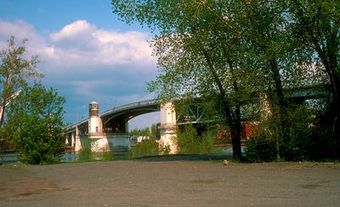Val-d'Or, Quebec, city incorporated in 1968, population 32,491 (2016 census), 31,862 (2011 census). Val-d'Or is located 95 km southeast of Rouyn-Noranda in northwestern Quebec's Abitibi-Témiscamingue region. The town is near the source of the Harricana River, one of the major rivers flowing north to James Bay. Val-d’Or’s name is linked to the gold rush, second in scale only to the Klondike, which took the area by storm in the mid-1930s. (See Gold Rushes in Canada.)
History
The town was originally made up of two separate municipalities. The first, Bourlamaque, was founded in 1934 by the Lamaque Mining Co as a company town. (See Mining.) The other, Val-d'Or, was incorporated as a village in 1935 and a town two years later. It started out as a bustling gold rush town. For many years, the twin centres were known as Val-d'Or-Bourlamaque. A third town, Lac Lemoyne, was formed in 1958. In 1968, the three towns amalgamated under the name Val-d'Or. It and Rouyn-Noranda are the largest municipalities in the Abitibi-Témiscamingue region.
Economy
Val-d'Or prospered from the dozens of gold mines discovered in the vicinity. (See Mining.) The Sigma mine, located within the town's limits, started operating in 1935. The mine was one of Quebec's richest gold-bearing mines. The Lamaque mine suspended operations in the mid 1980s, but this was offset by the discovery of a large reserve of copper, zinc and gold in 1989. Known as the Louvicourt mine, it began production in 1994. Gradual mine closures have, however, affected Val-d’Or’s economy over the years.
Former mining-related areas provide tourism and recreational opportunities. The first 65 log cabins of the Bourlamaque mining village built beside the Lamaque mine in 1934 are still in their original state. In 1979, the area was granted heritage status. The site commemorates the gold rush that brought Val-d’Or into existence. The nearby Cité de l’Or historic site is built on the old Lamaque mine. Visitors can explore the former mining site and visit underground mining galleries.
The lumber business is an important part of Val-d’Or’s economy. The forests of the Abitibi region provide 65 per cent of the lumber produced in Quebec. An industrial park, created in 1972, also provides jobs in numerous industries.
Val-d'Or is also a service centre. It has one of the busiest airports in Quebec. The town is also home to a large hospital and a Université du Québec en Abitibi-Témiscamingue campus. An exhibition centre promotes regional visual artists while a music conservatory offers musical training.

 Share on Facebook
Share on Facebook Share on X
Share on X Share by Email
Share by Email Share on Google Classroom
Share on Google Classroom


